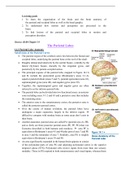Samenvatting
3.6 Neuropsychology summary
- Instelling
- Erasmus Universiteit Rotterdam (EUR)
Elaborate notes on all 4 problems of the neuropsychology course in clinical psychology specialization of the Psychology bachelor. Includes multiple helpful images of the brain and other visually helpful material.
[Meer zien]




